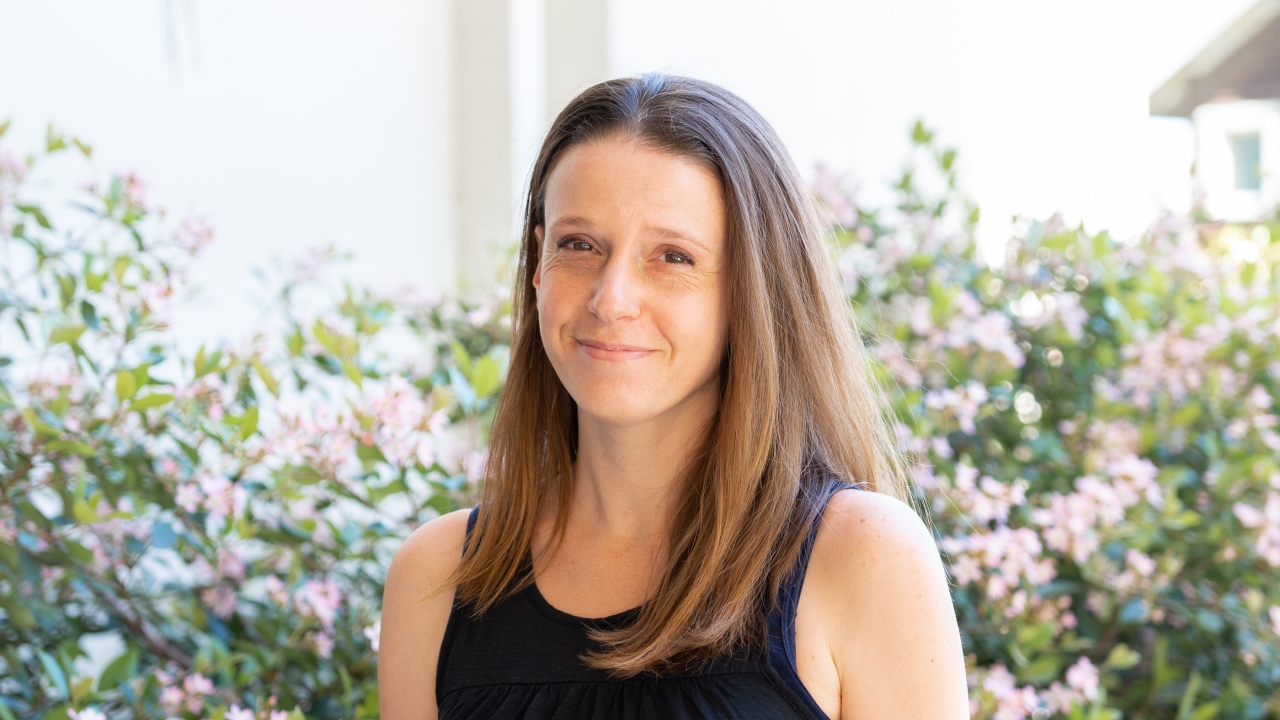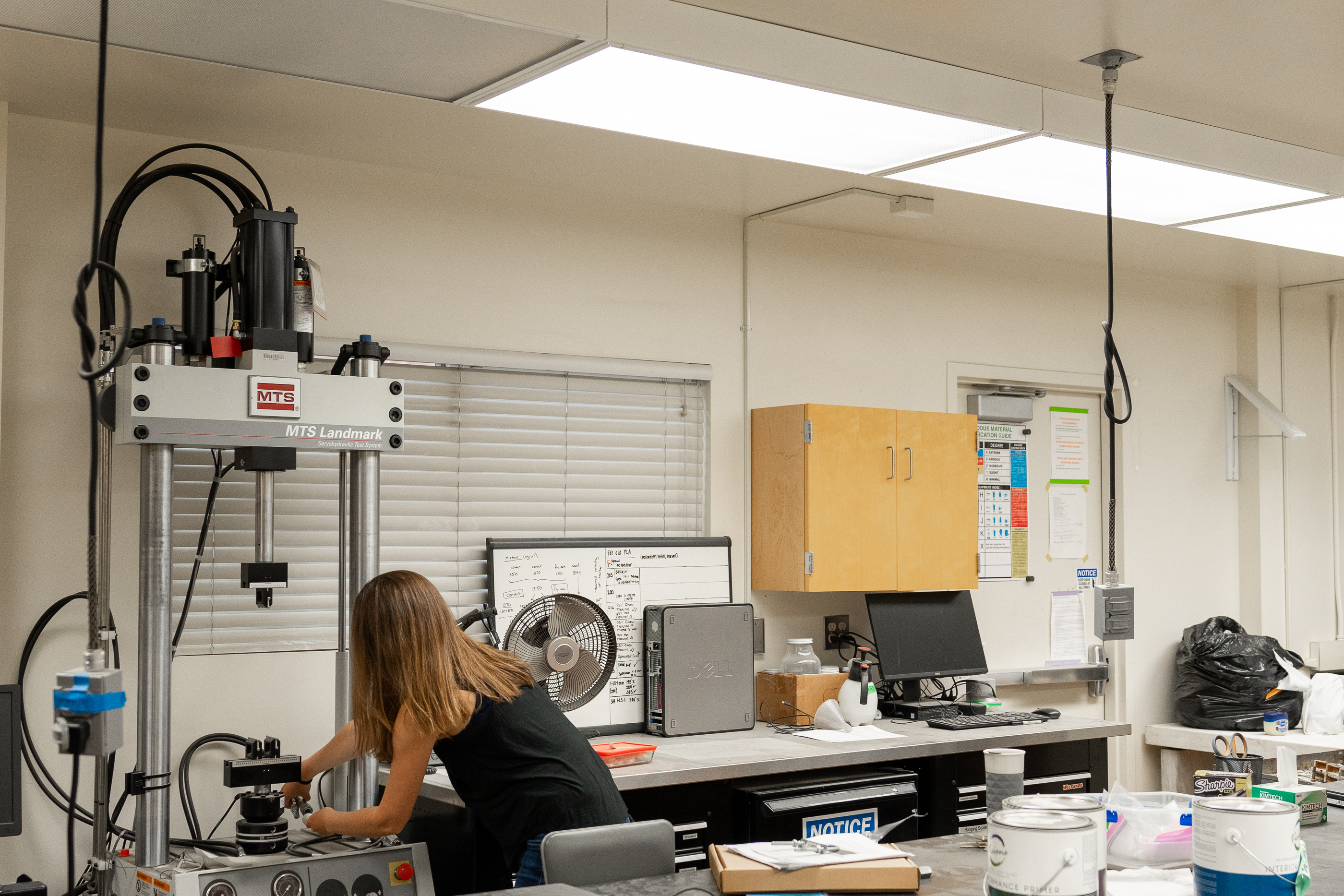
Sabbie Miller Paves the Way for Making Concrete Environmentally Safe
When Associate Professor of Civil and Environmental Engineering Sabbie Miller was a child, she talked her parents into converting their avocado farm to organic production.

“My mom claims that I was actually the one who insisted on the farm being organic, although I was so young that I don’t recall [doing that],” Miller said. “The farm was conventional [when we moved there] and I was apparently so upset that the dogs would be around toxic chemicals that I convinced them to go organic.”
Presumably embarrassed by the admission, she offered a defense for her younger self: “It’s not like I asked them to do something that would, you know, break their bottom line, but I’ve always been really worried about how things interact with the environment, looking at what we’re doing to it.”
Miller has upheld that innate concern about the environment since. Within the past few years, she’s directed a lot of that concern toward the environmental impacts of concrete — the most used human-made material in the world.
Since joining the Department of Civil and Environmental Engineering at the University of California, Davis, in 2016, Miller has founded two separate labs to study building materials: the Engineered Sustainable Infrastructure Materials and Structural Systems and the Resilient Infrastructure Materials laboratories.
Her research can broadly fall into three categories: seeking to quantify the environmental impacts of materials production and the efficacy of mitigation strategies, establishing tools and frameworks for building materials to be environmentally safe, and researching bio-based, sustainable materials that could be used in the built environment.
As a result of her work, Miller has been asked to participate in the United Nations Environment Program Sustainable Building and Climate Initiative, where she has served as an author on eco-efficient cement research, and the American Concrete Institute, which is responsible for writing the reinforced concrete design code that the construction industry must adhere to.
Miller’s work has also contributed to the successful passing of the landmark California legislature Senate Bill 596 in 2021. The first-of-its-kind law mandates that the Golden State reach a net-zero carbon emission rate from concrete production as soon as possible and no later than 2045.
“I suggest next time you're out for a walk, consider all the gray stuff that you're surrounded by,” she said with a playful tone belying the seriousness of her challenge. “You start to realize how much concrete we're actually surrounded by.”
The Concrete Impacts
Extending the view beyond our neighborhoods, per Miller’s challenge, it’s an even more staggering observation: We use 30 billion tons of the gray stuff around the globe every year. Its production also accounts for 8% of the world's carbon emissions.
Most greenhouse gas emissions attributed to concrete are from the manufacture of cement, which conventionally reacts with water to become what can be thought of as the glue that holds aggregate, or the pieces of crushed rock and sand, together to make concrete.
To create cement, fossil fuels are used to heat limestone, clays, and other materials to a very high temperature (think: 2600°F) in a kiln, releasing carbon dioxide in the process.
However, the thing is, concrete itself isn’t necessarily the cause of its outsized environmental burdens, explained Miller. What’s driving its high carbon emissions instead is our incredibly large consumption of it, which is only second to water.
That’s one of the primary issues that Miller wants to address in her research — how can we lessen the environmental burdens of a globally important resource? It’s a complicated question to answer.
An 'Overlooked' Research Field
Miller first became interested in concrete as a postdoctoral fellow in environmental engineering at the University of California, Berkeley when her advisor, Arpad Horvath, asked her to investigate the environmental impacts of concrete in the mid-2010s.
“Once I started doing various types of models [for the environmental impacts of concrete], we realized together, ‘Oh, this is a much bigger issue than we thought,’” Miller said.
The research she did at UC Berkeley resulted in a paper summarizing the challenges and accomplishments of reducing the environmental impacts of concrete, which the team published in Nature Materials in 2017. While they found that concrete or its production is not inherently bad for the environment, the incredibly high consumption rate is. That realization changed her career forever.
“Since then, it's been a field that I've continued to pursue because of the potential for substantial impacts,” she said. “We've been paying a lot of attention to reducing emissions from transportation and building energy use, and we have been for a while, whereas industrial emissions have actually been largely overlooked."
“Because odds are that we're going to keep using concrete. So, how do we make it something that's acceptable, something that doesn't cause huge environmental damage?”
Much of her work has centered around finding substitutes for cement, like rice hull ash, to reduce carbon emissions. In late 2022, her team published a report showing that 1.3 gigatons of carbon emissions across the globe could be diverted by using secondary materials in concrete. She’s also led promising research mandated by the CalEPA that may lead to carpet being upcycled into concrete, avoiding the landfill entirely.
“There are thousands and thousands and thousands of permutations of concrete,” Miller said, “and a lot of what our group does is trying to understand how we should be optimizing those different ratios. What can we do to reduce the impacts associated with producing cement? How can we engineer new mineral additives such that we don't need as much cement?”
Miller is also interested in turning the materials of the built environment, like the concrete in buildings, into carbon sinks. The Department of Energy’s Advanced Research Projects Agency-Energy recently funded a project of hers that proposes to make carbon sequestration in building materials a reality.
“Concrete is actually one of the few areas [that is large enough to] use it to sequester carbon dioxide that's in the atmosphere or that’s emitted from flue gas without having to use a geologic reserve and meaningful amounts of energy,” she said.
A Global Resource's Future
In general, Miller is uncomfortable with predictions. Yet she’s comfortable with her bet that concrete will be around for a while.

“I realize there's a huge interest in using other building materials that have potentially lower environmental impact types, but this is a really cheap material that we're very comfortable with and the construction industry is not the fastest to spin on a dime,” Miller said. “So, [in the coming years], we might be using this material in a way that really reduces the environmental impacts tied to it.”
Miller hopes to continue her research into carbon-sequestering materials and how they might positively impact things like human health. Of particular interest to her is addressing the environmental harm brought onto low-income communities through the production of materials like concrete.
On that last part, the future of concrete has already begun, according to Miller.
“We’re doing a fair bit with different types of state organizations [right now] and trying to understand policy levers that can benefit impacted communities,” Miller said. “And the amount of attention that federal and state policymakers are paying to building materials right now is really promising in terms of how quickly we might anticipate some breakthroughs coming into play for mitigating greenhouse gas emissions."
Paving the Way for Others
Miller likes to joke that she became a professor because it’s the family business. Both her parents are emeritus professors.
However, it wasn’t so easy for her to discover, as a kid who naturally gravitated toward math and science courses in school, that she could apply her passion for the natural world through engineering.
“I didn't know it was an option to look at the built environment and try to mitigate environmental impacts to try to understand how it interacts with the systems that are surrounding it [through civil and environmental engineering],” she said.
To help other kids realize that there are more doors in their life than they may realize, educational outreach has been important to Miller. When she was a student at Stanford, she taught science engagement courses for underrepresented middle and high schoolers in the Bay Area; at UC Davis, she has worked with K-12 students to help make STEM topics accessible and engaging.
“A lot of our outreach is trying to let students know what options are out there,” Miller said of her research group. “Not necessarily that they have to do this, but rather don't close doors and don't assume engineering is just math and nothing else. There are so many things that one can do as an engineer, and there's so much wonderful change that we can have as engineers. It's not just trying to get a building to stand but rather getting that building to stand, getting it to serve the people that need it and trying to undo the harm associated with all the buildings we made before.”




